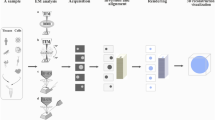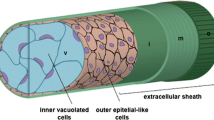Summary
Using freeze-fracture electron microscopy and fluorescent dye injection we have analysed the contacts between cells of the deeper endoderm taken from neurulae ofXenopus laevis. Endodermal cells in situ have large 1.5 μm diameter gap junctions composed of 8 nm P-face particles and corresponding E-face pits. Beside gap junctions, particle aggregates typical of desmosomal plaques are present but there are no tight junctions. The dissociation of endoderm into single cells involves profound structural alterations in the surface membrane including the complete disappearance of junctional structures among them gap junctions. The reaggregation of endoderm cells leads to the restoration of the surface membrane IMP (Intra Membrane Particle) pattern and, after ca. 30 min, to the establishment of functional pathways allowing for the intercellular transfer of fluorescent dye. Concomitantly gap junctions reappear. The observation that the dissociation and reaggregation of endodermal cells involves IMP alterations which go beyond the cell junctions themselves is discussed as an adaptation of the plasma membrane to changing environmental conditions.
Similar content being viewed by others
References
Bennett MVL, Trinkaus JP (1970) Electrical coupling between embryonic cells by way of extracellular space and specialized junctions. J Cell Biol 44:592–610
Branton D, Bullivant, S., Gilula NB, Karnovsky MJ, Moor H, Mühletaler K, Northcote DH, Packer L, Satir B, Satir P, Speth V, Staehelin LA, Steere RL, Weinstein R (1975) Freeze etching nomenclature. Science 190:54–56
Decker RS (1976) Hormonal regulation of gap junction differentiation. J Cell Biol 69:669–685
Decker RS, Friend DS (1974) Assembly of gap junctions during amphibian neurulation, J Cell Biol 62:32–47
DeHaan RL, Hirakow R (1972) Synchronization of pulsation rates in isolated cardiac myocytes. Exp Cell Res 70:214–220
de Laat SW, Luchtel D, Bluemink JG (1973) The action of cytochalasin B during egg cleavage inXenopus laevis: dependence on cell membrane permeability. Dev Biol 31:163–177
DiCaprio RA, French AS, Sanders EJ (1974) Dynamic properties of electronic coupling between cells of earlyXenopus embryos. Biophys J 14:387–411
DiCaprio RA, French AS, Sanders EJ (1975) Intercellular connectivity in the eight cellXenopus embryo. Biophys J 15:373–389
Hanna RB, Model PG, Spray DC, Bennett MVL, Harris AL (1980) Gap junctions in early amphibian embryos. Am J Anat 158:111–114
Hara K (1977) The cleavage pattern of the axolotl egg studied by cinematography and cell counting. Wilhelm Roux's Arch 181:73–87
Ito S, Hori N (1966) Electrical characteristics ofTriturus egg cells during cleavage. J Gen Physiol 49:1019–1027
Ito S, Loewenstein WR (1969) Ionic communication between early embryonic cells. Dev Biol 19:228–243
Johnson R, Hammer M, Sheridan J, Revel JP (1974) Gap junction formation between reaggregated Novikoff hepatoma cells. Proc Natl Acad Sci USA 71:4536–4540
Keller RE, Schoenwolf GC (1977) An SEM study of cellular morphology, contact and arrangement as related to gastrulation inXenopus laevis. Wilhelm Roux's Arch 182:165–186
Lane VJ, Swales LS (1980) Dispersal of junctional particles, not internalization, during the in vivo disappearance of gap junctions. Cell 19:579–586
Loewenstein WR (1967) On the genesis of cellular communication. Devel Biol suppl 2:151–183
Loewenstein WR (1979) Junctional intercellular communication and the control of growth. Biochim Biophys Acta 560:1–65
Müller M, Meister N, Moor H (1980) Freezing in a propane jet and its application in freeze fracturing. Mikroskopie (Wien) 36:129–140
Nieuwkoop PD, Faber J (1967) Normal table ofXenopus laevis (Daudin) North-Holland Publ, Amsterdam
Palmer JF, Slack C (1970) Some bioelectric parameters of earlyXenopus embryos J Embryol Exp Morphol 24:535–553
Peracchia C (1980) Structural correlates of gap junctions permeation. Int Rev Cytol 66:81–146
Pfenninger KH, Rinderer ER (1975) Methods for freeze fracturing of nerve tissue cultures and cell monolayers. J Cell Biol 53:777–787
Revel JP, Griepp E, Finbow M, Johnson R (1978) Possible steps in gap junction formation. Zoon 6:139–144
Sanders EJ, DiCaprio RA (1976) Intercellular junctions in theXenopus embryo prior to gastrulation. J Exp Zool 197:415–421
Sheridan JD (1971) Dye movement and low-resistance junctions between reaggregated embryonic cells. Dev Biol 26:627–636
Slack C, Palmer JF (1969) The permeability of intercellular junctions in the early embryo ofXenopus laevis studied with a fluorescent tracer. Exp Cell Res 55:416–419
Slack C, Warner AE (1975) Properties of surface and junctional membranes of embryonic cells isolated from gastrula stages ofXenopus laevis. J Physiol 248:97–120
Spiegel M (1951) A method for the removal of the jelly and vitelline membrane of the egg ofRana pipiens Anat Rec 111:554
Spray DC, Harris AL, Bennett MVL (1979) Voltage dependence of junctional conductance in early amphibian embryos. Science 204:432–434
Steinberg M (1957) Carnegie Inst Wash Year Book 56:347
Stewart WW (1978) Functional corrections between cells as revealed by dye coupling with a highly fluorescent naphthalimide tracer. J Cell Biol 14:741–759
Stockem W (1970) Die Eignung von Pioloform für Herstellung elektronenmikroskopischer Trägerfilme Mikroskopie 26:185–189
Turin L, Warner AE (1980) Intracellular pH in earlyXenopus embryos: its effect on current flow between blastomeres. J Physiol 300:489–504
Wood RL, Kuda AM (1980) Formation of junctions in regenerating Hydra: gap junctions. J Ultrastr Res 73:350–360
Author information
Authors and Affiliations
Rights and permissions
About this article
Cite this article
Sugimoto, K., Hage, W.J. & Bluemink, J.G. Gap junction formation between normal and reaggregated endoderm cells ofXenopus laevis neurulae. Wilhelm Roux' Archiv 191, 143–148 (1982). https://doi.org/10.1007/BF00848328
Received:
Accepted:
Issue Date:
DOI: https://doi.org/10.1007/BF00848328




